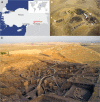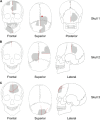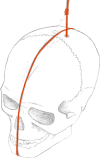Modified human crania from Göbekli Tepe provide evidence for a new form of Neolithic skull cult
- PMID: 28782013
- PMCID: PMC5489262
- DOI: 10.1126/sciadv.1700564
Modified human crania from Göbekli Tepe provide evidence for a new form of Neolithic skull cult
Abstract
Archaeological excavations at Göbekli Tepe, a transitional Neolithic site in southeast Turkey, have revealed the earliest megalithic ritual architecture with characteristic T-shaped pillars. Although human burials are still absent from the site, a number of fragmented human bones have been recovered from fill deposits of buildings and from adjacent areas. We focus on three partially preserved human skulls, all of which carry artificial modifications of a type so far unknown from contemporaneous sites and the ethnographic record. As such, modified skull fragments from Göbekli Tepe could indicate a new, previously undocumented variation of skull cult in the Early Neolithic of Anatolia and the Levant.
Keywords: Anatolia; Human skull; Pre-Pottery Neolithic; carving; ritual; taphonomy.
Figures





Similar articles
-
Cereal processing at Early Neolithic Göbekli Tepe, southeastern Turkey.PLoS One. 2019 May 1;14(5):e0215214. doi: 10.1371/journal.pone.0215214. eCollection 2019. PLoS One. 2019. PMID: 31042741 Free PMC article.
-
Crania with mutilated facial skeletons: a new ritual treatment in an early pre-pottery Neolithic B cranial cache at Tell Qarassa North (South Syria).Am J Phys Anthropol. 2012 Oct;149(2):205-16. doi: 10.1002/ajpa.22111. Epub 2012 Jul 11. Am J Phys Anthropol. 2012. PMID: 22782494
-
[Skull cult. Trophy heads and tzantzas in pre-Columbian America].Rev Neurol. 2012 Jul 16;55(2):111-20. Rev Neurol. 2012. PMID: 22760771 Spanish.
-
Research in the prehistory of central Western iran.Science. 1966 Jul 22;153(3734):386-91. doi: 10.1126/science.153.3734.386. Science. 1966. PMID: 17839705
-
Large-scale investigations of Neolithic settlement dynamics in Central Germany based on machine learning analysis: A case study from the Weiße Elster river catchment.PLoS One. 2022 Apr 20;17(4):e0265835. doi: 10.1371/journal.pone.0265835. eCollection 2022. PLoS One. 2022. PMID: 35442952 Free PMC article. Review.
Cited by
-
Burying power: New insights into incipient leadership in the Late Pre-Pottery Neolithic from an outstanding burial at Ba'ja, southern Jordan.PLoS One. 2019 Aug 28;14(8):e0221171. doi: 10.1371/journal.pone.0221171. eCollection 2019. PLoS One. 2019. PMID: 31461467 Free PMC article.
-
Bone spoons for prehistoric babies: Detection of human teeth marks on the Neolithic artefacts from the site Grad-Starčevo (Serbia).PLoS One. 2019 Dec 19;14(12):e0225713. doi: 10.1371/journal.pone.0225713. eCollection 2019. PLoS One. 2019. PMID: 31856238 Free PMC article.
-
Isotopic and DNA analyses reveal multiscale PPNB mobility and migration across Southeastern Anatolia and the Southern Levant.Proc Natl Acad Sci U S A. 2023 Jan 24;120(4):e2210611120. doi: 10.1073/pnas.2210611120. Epub 2023 Jan 17. Proc Natl Acad Sci U S A. 2023. PMID: 36649412 Free PMC article.
-
New insights on commemoration of the dead through mortuary and architectural use of pigments at Neolithic Çatalhöyük, Turkey.Sci Rep. 2022 Mar 8;12(1):4055. doi: 10.1038/s41598-022-07284-3. Sci Rep. 2022. PMID: 35260577 Free PMC article.
References
-
- Schädelkult, Kopf und Schädel in der Kulturgeschichte des Menschen, A. Wieczorek, W. Rosendahl, Eds. (Schnell und Steiner, 2011), pp. 47–51.
-
- J. Cauvin, Religions néolithiques de Syro-Palestine: Documents (Publications du Centre de Recherches d’Ecologie et de Préhistoire, Saint-André-De-Cruzières, 1972).
-
- Bienert H.-D., Skull cult in the prehistoric Near East. J. Prehist. Rel. 5, 9–23 (1991).
-
- J. Wahl, Karies, Kampf und Schädelkult–150 Jahre anthropologische Forschung in Südwestdeutschland (K. Theiss, 2007).
-
- Kanjou Y., Study of Neolithic human graves from Tell Qaramel in North Syria. Int. J. Mod. Anthrop. 2, 25–37 (2009).
Publication types
MeSH terms
LinkOut - more resources
Full Text Sources
Other Literature Sources
Research Materials

